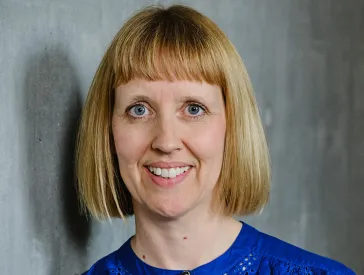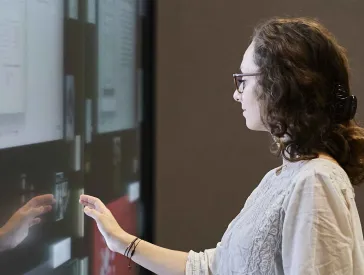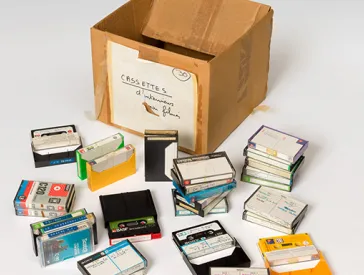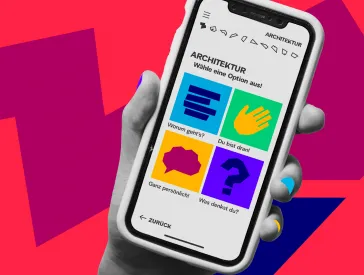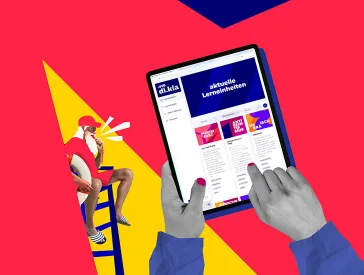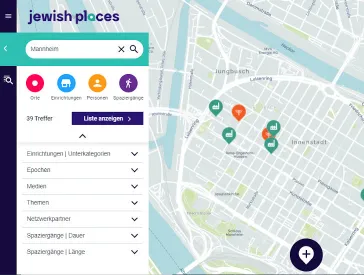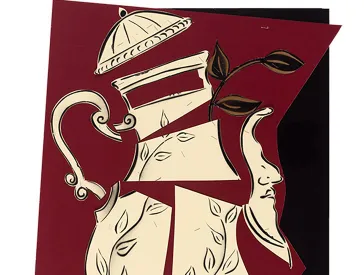“Diverse perspectives are essential.”
Interview with Barbara Thiele
Since June 2024, Barbara Thiele has served as Director of Education and Digital Engagement at the Jewish Museum Berlin. She oversees the museum’s education and events program, the ANOHA Children’s World, digital transformation, and visitor research. In 2016, she was appointed Head of Digital & Publishing, where she and her team were responsible for developing and implementing the museum’s websites, along with numerous publications and digital education initiatives.
As Director of Education and Digital Engagement, you’re responsible for a wide range of departments, including Education, the ANOHA Children’s World, the JMB Academy, Event Management, and Visitor Experience & Research. Digital & Publishing also falls under your remit. What opportunities does this newly created position offer?
For the first time, all of the museum’s departments that present our themes alongside the exhibitions and are in close contact with visitors have been brought together under a single director. The reorganization is intended to create structural links between the program development departments and the two organizational units: Event Management and Visitor Experience & Research. This generates significant new synergies.
We are now developing a cross-departmental education and engagement strategy to foster broad social participation through a diverse range of audience-specific programs. Other priorities include outreach development, program sustainability, and approaches to digitization. Assigning responsibility for the strategic field of digital transformation to the directorate has been a crucial step, as it enables us to systematically integrate analog and digital formats and to continue developing the JMB’s work in a sustainable and effective way. In doing so, we can expand access to the museum on multiple levels – and reach people far beyond Berlin.
In these politically turbulent times, how can the JMB Academy contribute to society through its programs?
The academy’s mission is to explore Jewish culture in Germany, past and present. It welcomes diverse – even contradictory – perspectives, which it regards as essential for a pluralistic, democratic society. Its programs, including the new Digital Lecture Series, provide historical context for today’s debates. As part of our broader digital transformation, the digital lectures – like many of our events – can be viewed on our website. Yet the academy’s activities extend beyond panel discussions: it also hosts exhibition-related events, the Cultural Summer, Jazz in the Garden, the annual Family Festival, and the library’s regular book clubs.
Barbara Thiele; Jewish Museum Berlin, photo: André Wagenzik
What different educational programs are needed to reach the museum’s diverse target groups?
Inclusion and participation are cross-departmental priorities at the JMB and naturally play an important role in our daily work. We are committed to developing programs that are as accessible as possible and can be used by a broad audience. At the same time, we address specific target groups to ensure their participation. For visitors with hearing or visual impairments, we provide resources such as sign language videos, tactile models, audio descriptions, and digital formats compatible with screen readers. We offer content in Simple Language and have created a dedicated program for people with dementia called Pictures Make People.
School students are one of our key audiences. We continue to expand our program of guided tours and workshops, and our appbased Young Perspectives tour enables young visitors to explore the core exhibition interactively. Across all our programs, a central focus is the active involvement of the target groups themselves. For example, when developing the digital classroom JMB di.kla, we worked closely with a teachers’ advisory board. Just as essential, in my view, is the ongoing evaluation and adaptation of our programs – the only way for a museum to remain relevant.
The ANOHA Children’s World makes use of hardly any media applications – why?
Digital transformation is not about technology for its own sake. We deliberately use digital formats only when they meaningfully complement and enrich our content. ANOHA is one of the most successful audience development projects in the international museum landscape, and anyone who visits quickly sees why so few media applications are used there. From the moment they enter, children embark on a journey of discovery. They experience the story of Noah’s Ark in a playful, immersive way, engaging in dialogue with our communicators. They can ask a wide range of questions – about nature, environment, religion, diversity, and identity. Children aged seven to ten can explore Listen Up!, a media-based search game based almost entirely on audio stories. Yet our experience shows that even older children enjoy splashing through puddles in the Rain Tunnel, discovering the story of the Flood, and building and launching small arks. When I visit, I always climb onto the giant anaconda – it’s my favorite spot in ANOHA.
Listen Up! at the ANOHA; Jewish Museum Berlin, 2025
How important is the exchange of ideas with other organizations and museums?
For me, exchanging ideas with colleagues from other museums has always been crucial. Since 2021, I have served as co-spokesperson for the Digital Transformation Working Group of the Berlin Museum Association. We all face similar challenges and do our best to support one another. Right now, for instance, we’re discussing how artificial intelligence can be used in museums, archives, and other memory institutions. The JMB has long been – and remains – a pioneer and driving force in visitor research. Our Visitor Experience & Research Department helped found the Visitor Research Network, which meets annually to share insights. The community project Jewish Places likewise emerged from this spirit of cooperation. In the coming years, we hope to deepen our collaboration with other institutions, since sharing knowledge and experience sustains and enriches our work.
What role can artificial intelligence play in assessing and communicating history?
The JMB already makes extensive use of artificial intelligence to translate large datasets – for example, in creating the English versions of Jewish Places and for video subtitles. In my view, one of the greatest opportunities lies in using text and speech recognition to analyze, index, and present vast collections of historical documents, photographs, letters, and audio recordings – including materials that were previously difficult to read or rarely catalogued. At the same time, we are also seeing the limits of AI. When working with Claude Lanzmann’s audio archive, for example, we noticed that the AI in use was overwhelmed by the recordings and unable to accurately process the many languages spoken on the old cassettes. Looking ahead, we will need better datasets to train large language models, and we must also address the important issue of data sovereignty.
For all its potential, AI also comes with risks. It can generate deceptively authentic-looking “historical” images, documents, and eyewitness accounts. AI does not rely on facts alone, but on data patterns that may be skewed by one-sided training. In this context, museums and cultural institutions have a key role to play as mediators and educators: they must consistently contextualize AI-generated content and never present it as objective truth. Museums, in particular, have a historical responsibility in this regard.
The JMB will soon celebrate its 25th anniversary. What are your hopes for the JMB in the future?
For twenty-five years, an extraordinarily creative and dedicated team has worked at the museum to present Jewish culture – past and present – to visitors from many different perspectives. My hope for the future is that our themes will continue to inspire people, encouraging reflection and dialogue. In this way, we can help ensure that our democratic society remains open and pluralistic.
Thank you for the interview!
The interview was conducted by Marie Naumann and Katharina Wulffius.
Citation recommendation:
Marie Naumann, Katharina Wulffius (2025), “Diverse perspectives are essential.”. Interview with Barbara Thiele.
URL: www.jmberlin.de/en/node/10774


